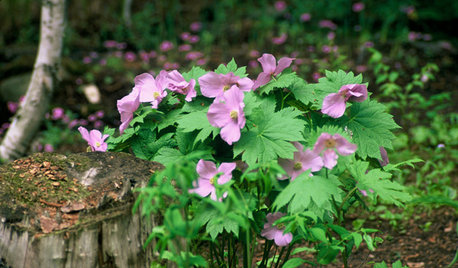Micropropagation/Tissue Culture of various plants and Inositol
wirtlo
18 years ago
Related Stories

GARDENING GUIDESWe Bust 4 More Native Plant Myths
Have you been taken in by these fallacies about gardening with native plants?
Full Story
GARDENING GUIDES7 Shade-Loving Rarities of the Plant World
Cultivate a discriminating air in a shady garden patch with these uncommon woodland wonders
Full Story
DECORATING GUIDESColor Guide: How to Work With Red
Sizzling or sedate, red is not for the timid. Here's how to use its boldness to make your rooms come alive
Full Story
BATHROOM DESIGN20 Ways to Design an Asian-Style Bathroom
Want a bathroom that’s inviting and serene, with spa-like luxury? Be inspired by these Asian-style spaces, which offer all that and more
Full Story
ORGANIZING‘Tidying Up’ Author Marie Kondo Tells How to ‘Spark Joy’ at Home
A new book from the author of ‘The Life-Changing Magic of Tidying Up’ delves deeper into her KonMari Method of decluttering and organizing
Full Story
FEEL-GOOD HOME21 Ways to Waste Less at Home
Whether it's herbs rotting in the fridge or clothes that never get worn, most of us waste too much. Here are ways to make a change
Full Story
MOST POPULAR7 Ways to Design Your Kitchen to Help You Lose Weight
In his new book, Slim by Design, eating-behavior expert Brian Wansink shows us how to get our kitchens working better
Full Story
MATERIALSAre You a Maker? Show Us Your Favorite Tool or Material
Houzz Call: A tool or material can be a maker’s best friend. We’d like to see your favorite — and what it helps you achieve
Full Story
ARCHITECTUREWhat the Future Holds for 3D Printing in Architecture and Design
Designers worldwide are creating 3D-printed buildings, furnishings and materials. Will we be seeing this trend in our homes?
Full Story
FUN HOUZZ31 True Tales of Remodeling Gone Wild
Drugs, sex, excess — the home design industry is rife with stories that will blow your mind, or at least leave you scratching your head
Full StoryMore Discussions






geoforce
albert_135 39.17°N 119.76°W 4695ft.
Related Professionals
Maple Valley Landscape Architects & Landscape Designers · Camas Landscape Architects & Landscape Designers · Garden City Landscape Architects & Landscape Designers · Berkeley Heights Landscape Contractors · El Reno Landscape Contractors · Fort Wayne Landscape Contractors · Gloucester Landscape Contractors · Inglewood Landscape Contractors · Oak Forest Landscape Contractors · Richmond Landscape Contractors · Saint Paul Landscape Contractors · Suitland Landscape Contractors · Watertown Landscape Contractors · Woodbury Landscape Contractors · Silver Firs Landscape Contractorsenna123
Tim
zaleon
tcuser
albert_135 39.17°N 119.76°W 4695ft.
tcuser
sandhya_singh055_gmail_com